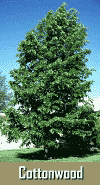Cottonwood (Poplar)
The cottonwood—also known as the poplar—is a tall tree with a spreading crown, named for its cotton-like seeds. The diverse poplar family includes the quaking aspen, which boasts the widest range of any North American tree, and the Plains cottonwood, which was the only tree many early settlers met as they forged westward through America's prairies. Today as in centuries past, the cottonwood offers welcome shade, as its powerful trunk divides into thick branches and opens into a spreading crown. Many cottonwoods grow from 70 to 100 feet tall, and the tree’s quick growth rate and adaptability to many soils and climates have made it an age-old friend to the American people.
The Cottonwood’s Place in History
Few sights were more welcome to America’s early pioneers than the cottonwood. As they pushed westward with their wagons, these brave men and women found food for their livestock in the tree's leaves, as well as shade for themselves and timber for their dwellings. The beauty of the cottonwood leaves as they turned in the wind may also have revived memories of eastern forests, and sustained many a flagging spirit. On the more practical side, cottonwood trunks provided dugout canoes, and the tree’s bark was used to produce both forage for horses and a bitter medicinal tea. And in regions with few trees, the very noticeable cottonwoods often served as gathering places and trail markers, and as sacred objects for several Plains tribes. Today, cottonwood is most commonly used in making plywood, matches, crates, boxes, and paper pulp.
Some Common Species
Quaking aspen (Populus tremuloides) is a slender, graceful tree, as attractive for its rounded mature crown and delicate branches as for its white bark and shimmering leaves. The “silver dollar” leaves, hanging from long, flexible leafstalks, turn in even the slightest breeze, reflecting light from their lustrous upper surface. This medium-sized tree, usually from 40 to 50 feet tall with a 20 to 30-foot spread, is found naturally in Alaska and lower California as well as from the New England states southward to Pennsylvania and westward to Missouri. It is valued for pulp production and for its role as one of the first trees to appear in areas that have been struck by fire and other natural disasters. But for many, the quaking aspen is just as valuable for its beauty, with its rustling leaves and striking white bark, growing along the sunny edges of America’s meadows and forests. (Grows in hardiness zones 1 to 7.)
The Plains cottonwood (Populus sargentii) has long been prized in the Great Plains states, where it was often the earliest and tallest tree to grow at the time of Western settlement. This attractive tree, which grows from 50 to 75 feet tall, is found throughout the Great Plains in locations with moist, low ground. It continues to be a source of shelter and shade across the region, building upon its legendary status as a friend to the early pioneers. (Grows in hardiness zones 3 to 9.)

Populus
Species
- Balsam Poplar
- Bigtooth Aspen
- Black Cottonwood
- Eastern Cottonwood
- Fremont Cottonwood
- Lanceleaf Cottonwood
- Lombardy Black Poplar
- Narrowleaf Cottonwood
- Plains Cottonwood
- Quaking Aspen
- White Poplar
